July 2025
North America News
In the US, when hazards are identified in consumer products, they will be recalled and published in the Consumer Product Safety Commission (CPSC) Recent Recalls on the CPSC website, which is updated daily. The US recalls from 01 June 2025 to 30 June 2025 are summarized below:
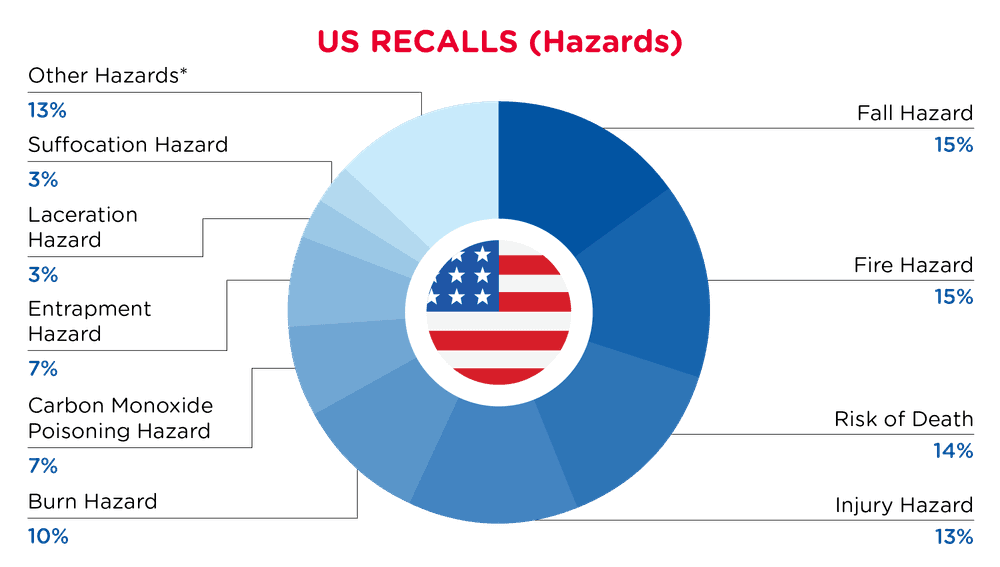
| Hazards | Frequency |
| Fall Hazard | 9 |
| Fire Hazard | 9 |
| Risk of Death | 8 |
| Injury Hazard | 8 |
| Burn Hazard | 6 |
| Carbon Monoxide Poisoning Hazard | 4 |
| Entrapment Hazard | 4 |
| Laceration Hazard | 2 |
| Suffocation Hazard | 2 |
| Other Hazards* | 8 |
*Other Hazards include Drowning Hazard, Electric Shock Hazard, Risk of Mold Exposure, Choking Hazard, Impact Hazard, Ingestion Hazard, Tip-Over Hazard and Amputation Hazard with a frequency of less than 2.
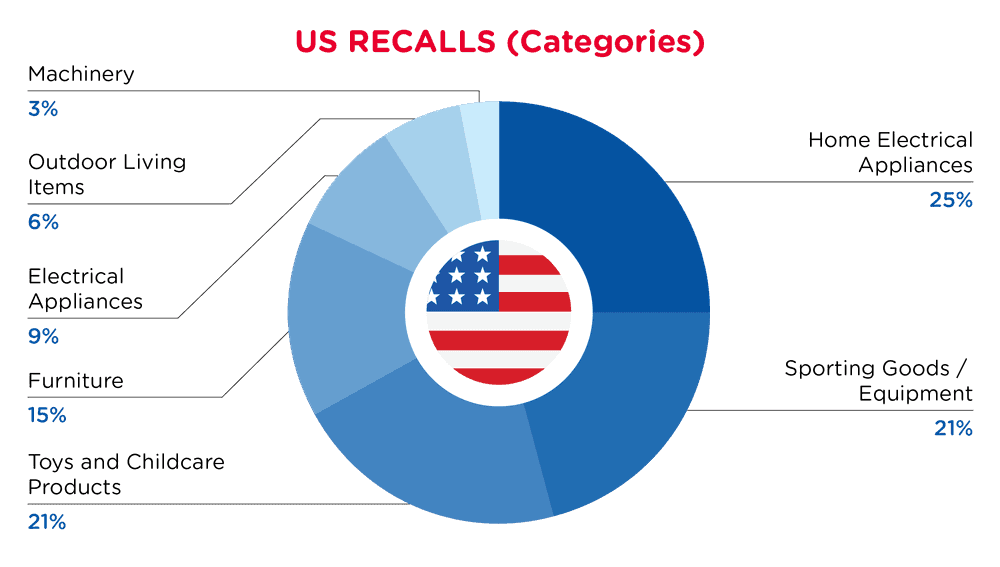
| Product Categories | Frequency |
| Home Electrical Appliances | 8 |
| Sporting Goods / Equipment | 7 |
| Toys and Childcare Products | 7 |
| Furniture | 5 |
| Electrical Appliances | 3 |
| Outdoor Living Items | 2 |
| Machinery | 1 |
For a complete list click here
In Canada, when hazards are identified in consumer products, they will be recalled and published in the Recalls and Safety Alerts Database on the Health Canada website, which is updated daily. The Canada recalls from 01 June 2025 to 30 June 2025 are summarized below:
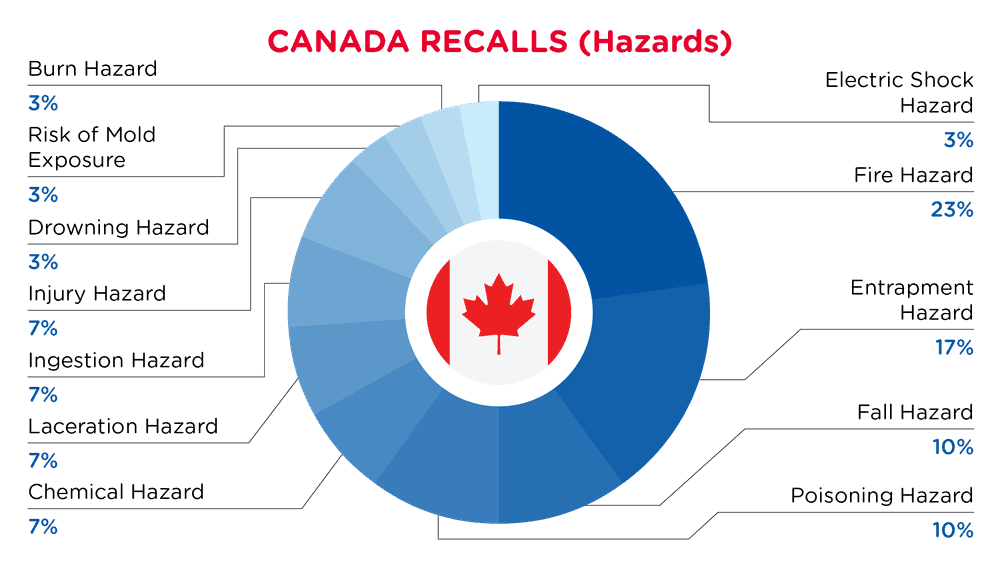
| Hazards | Frequency |
| Fire Hazard | 7 |
| Entrapment Hazard | 5 |
| Fall Hazard | 3 |
| Poisoning Hazard | 3 |
| Chemical Hazard | 2 |
| Laceration Hazard | 2 |
| Ingestion Hazard | 2 |
| Injury Hazard | 2 |
| Drowning Hazard | 1 |
| Risk of Mold Exposure | 1 |
| Burn Hazard | 1 |
| Electric Shock Hazard | 1 |
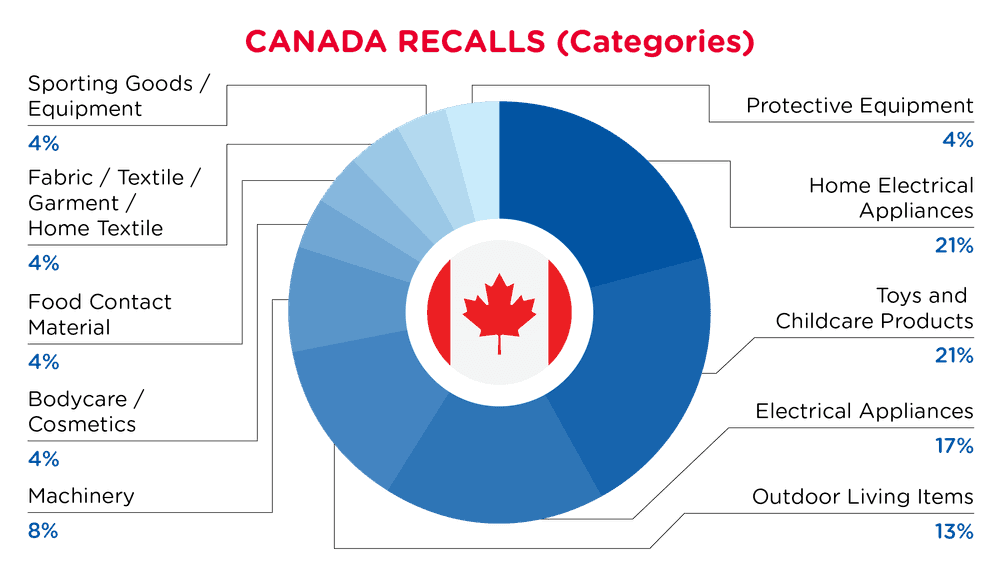
| Product Categories | Frequency |
| Home Electrical Appliances | 5 |
| Toys and Childcare Products | 5 |
| Electrical Appliances | 4 |
| Outdoor Living Items | 3 |
| Machinery | 2 |
| Bodycare / Cosmetics | 1 |
| Food Contact Material | 1 |
| Fabric / Textile / Garment / Home Textile | 1 |
| Sporting Goods / Equipment | 1 |
| Protective Equipment | 1 |
For a complete list click here
Europe News
In Europe, when hazards are identified in non-food consumer products, the products will be recalled and published in the Safety Gate system, which is updated weekly. The European recalls from 01 June 2025 to 30 June 2025 are summarized below:
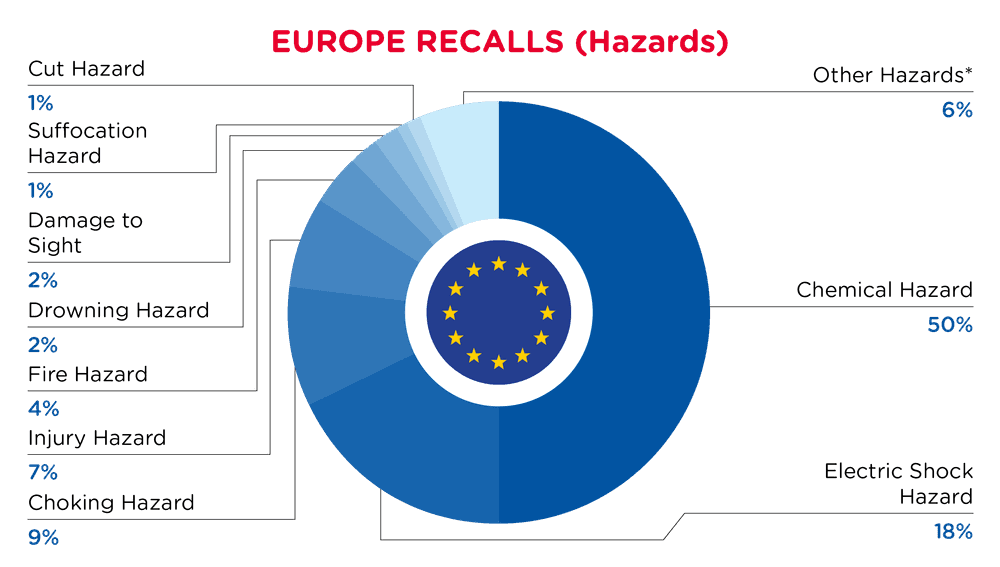
| Hazards | Frequency |
| Chemical Hazard | 226 |
| Electric Shock Hazard | 83 |
| Choking Hazard | 41 |
| Injury Hazard | 31 |
| Fire Hazard | 17 |
| Drowning Hazard | 10 |
| Damage to Sight | 7 |
| Suffocation Hazard | 6 |
| Cut Hazard | 5 |
| Other Hazards* | 26 |
*Other Hazards include Health Risk Hazard, Environmental Hazard, Burn Hazard, Microbiological Hazard, Asphyxiation Hazard, Damage to Hearing, Strangulation Hazard and Entrapment Hazard with a frequency of less than 5.

| Product Categories | Frequency |
| Bodycare / Cosmetics | 170 |
| Home Electrical Appliances | 97 |
| Toys and Childcare Products | 66 |
| Chemicals | 22 |
| Sporting Goods / Equipment | 22 |
| Fabric / Textile / Garment / Home Textile | 12 |
| Jewelry | 8 |
| Other Hazards* | 22 |
*Other Categories include Tools and Hardware, Electrical Appliances, Protective Equipment, Computer / Audio / Video / Other Electronics & Accessories, Machinery, Stationery, Outdoor Living Items and Household Items with a frequency of less than 7.
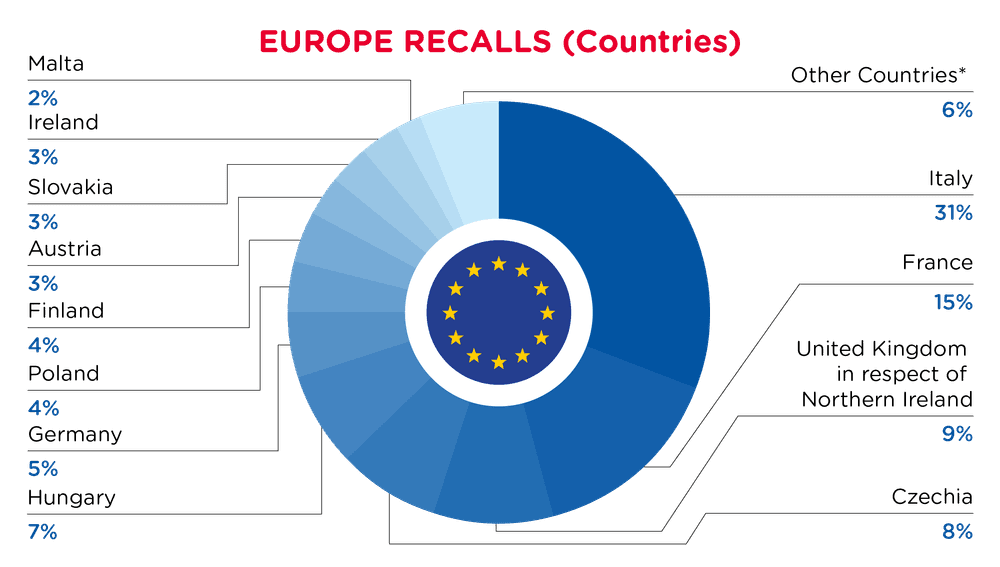
| Notifying Country | Frequency |
| Italy | 129 |
| France | 62 |
| United Kingdom in respect of Northern Ireland | 36 |
| Czechia | 35 |
| Hungary | 31 |
| Germany | 22 |
| Poland | 18 |
| Finland | 16 |
| Austria | 14 |
| Slovakia | 11 |
| Ireland | 11 |
| Malta | 8 |
| Other Countries | 26 |
*Other Countries include Croatia, Sweden, Spain, Latvia, Lithuania, Iceland, Cyprus, The Netherlands and Luxembourg with a frequency of less than 7.
For a complete list click here
The European Union (EU) has finalized the Council’s compromise text for the proposed Toy Safety Regulation (TSR), which will replace Directive 2009/48/EC. The new TSR introduces comprehensive updates to chemical, physical, mechanical, and digital safety requirements for toys placed on the EU market, while ensuring alignment with the General Product Safety Regulation (EU) 2023/988. A key feature is the introduction of a Digital Product Passport (DPP), which aims to improve transparency, traceability, and market surveillance.
In June 2025, the Council of the European Union adopted its final compromise text for the new Toy Safety Regulation (TSR). This regulation repeals Directive 2009/48/EC (Toy Safety Directive, (TSD)) and aims to address evolving technological, chemical, and consumer safety challenges.
The new TSR draft introduces significant revisions to the TSD, including but not limited to:
1. Scope and Exclusions
The regulation applies to all products designed for or intended for play by children under 14 years of age, including products with additional functions beyond play such as digital functions, artificial intelligence (AI) capabilities and connected features
Exclusions from Toy Definition:
Scooters designed for children with a body mass exceeding 20 kg
Books intended for children older than 36 months, provided they are made entirely of paper or cardboard without play value or added components
2. Enhanced Chemical Safety Requirements
Chemical Safety Assessment Enhancements: Manufacturers must consider both individual chemical exposure and combined exposure hazards in toys
Expansion of Chemical Bans:
| 2009/48/EC | Final Draft of TSR |
| Substances classified as carcinogenic, mutagenic, or toxic for reproduction (CMR substances) under Regulation (EC) No. 1272/2008 for classification, labeling and packaging of substances and mixtures (CLP) | Substances under Regulation (EC) 1272/2008 classified as • Carcinogenic, mutagenic, or toxic for reproduction (CMR substances) • Endocrine disruptors (ED) categories 1 or 2 for human health and the environment • Specific target organ toxicity (STOT) category 1 (single or repeated exposure) • Respiratory sensitizers category 1 • Skin sensitizers category 1A |
Prohibition of Specific Chemicals:
The intentional use of per- and polyfluoroalkyl substances (PFAS) is prohibited
34 bisphenols identified by the European Chemicals Agency (ECHA) as toxic for reproduction or endocrine disruptors under the CLP regulation 1272/2008, including the following bisphenols, are banned in toys:
| CAS Number | Name of bisphenol |
| 77-40-7 | 4,4'-(1-methylpropylidene)bisphenol (bisphenol B, BPB) |
| 79-97-0 | 4,4’-isopropylidenedi-o-cresol (bisphenol C, BPC) |
| 85-60-9 | 6,6'-di-tert-butyl-4,4'- butylidenedi-m-cresol |
| 118-82-1 | 2,2',6,6'-tetra-tert-butyl-4,4'-methylenediphenol (TBMD) |
| 1745-89-7 | 4,4'-isopropylidenebis[2-allylphenol] |
| 5613-46-7 | 4,4'-isopropylidenedi-2,6-xylol |
| 19224-29-4 | 2,2'-[(1-methylethylidene)bis(4,1-phenyleneoxy)]bisethyl diacetate |
| 27689-12-9 | (1-methylethylidene)bis(4,1-phenyleneoxy-3,1-propanediyl) bismethacrylate |
| 95235-30-6 | 4-(4-isopropoxyphenylsulfonyl)phenol |
| 41481-66-7 | 2,2'-diallyl-4,4'-sulfonyldiphenol (TG-SA) |
Chemical Substance Requirements Updates:
Nitrosamines and nitrosatable substances in toys are restricted in five categories of toys:
| N-nitrosamines (mg/kg) | N-nitrosatable substances (mg/kg) | |
| a) Toys intended for use by children under 36 months and intended or likely to be placed in the mouth | 0.01 | 0.1 |
| b) Toys intended for use by children under 36 months not covered by point a) above | 0.05 | 1.0 |
| c) Toys intended for use by children of 36 months and over and intended to be placed in the mouth | 0.05 | 1.0 |
| d) Balloons | 0.05 | 1.0 |
| e) Finger paints, slimes and putties | 0.02 | 1.0 |
*new or revised requirements are in italic and blue
Restrictions are imposed on the following chemicals across all toys:
| Substance | CAS numbers | Requirement Limit |
| TCEP | 115-96-8 | 5 mg/kg |
| TCPP | 13674-84-5 | 5 mg/kg |
| TDCP | 13674-87-8 | 5 mg/kg |
| Formamide | 75-12-7 | 20 μg/m3 (emission limit) after a maximum of 28 days from commencement of the emission testing of foam toy materials containing more than 200 mg/kg (cut-off limit based on content) |
| 1,2-benzisothiazol 3(2H)-one (BIT) | 2634-33-5 | 5 mg/kg in aqueous toy materials |
| 5-Chloro-2-methyl isothiazolin-3(2H)-one (CIT) | 26172-55-4 | 0.75 mg/kg in aqueous toy materials |
| Phenol | 108-95-2 | 5 mg/l (migration limit) in polymeric materials 10 mg/kg (content limit) as a preservative |
| Formaldehyde | 50-00-0 | 1.5 mg/l (migration limit) in polymeric toy material 0.062 mg/m3 (emission limit) in wood toy material 30 mg/kg (content limit) in textile toy material 30 mg/kg (content limit) in leather toy material 30 mg/kg (content limit) in paper toy material 10 mg/kg (content limit) in water-based toy material |
| Aniline | 62-53-3 | 30 mg/kg (content limit) after reductive cleavage in textile toy material and leather toy material 10 mg/kg (content limit) as free aniline in finger paints 30 mg/kg (content limit) after reductive cleavage in finger paints |
| Styrene | 100-42-5 | 0.77 mg/l (migration limit) in polymeric toy materials |
| Bisphenol A | 80-05-7 | 0.005 mg/l (migration limit) |
| Acrylonitrile | 107-13-1 | 0.01 mg/l (migration limit) in polymeric toy materials |
| Butadiene | 106-99-0 | 0.07 mg/l (migration limit) in polymeric toy materials |
| Vinyl chloride | 75-01-4 | 0.01 mg/l (migration limit) in polymeric toy materials |
*new or revised requirements are in italic
Allergenic Fragrance Updates:
Allergenic fragrances are prohibited in toys intended for children under 36 months or those meant to be placed in the mouth unless their presence is technically unavoidable under Good Manufacturing Practices (GMP) and do not exceed a concentration of 10 mg/kg (reduced from the current limit of 100 mg/kg)
Fragrances must be listed on the toy's label or accompanying documentation and be included in the DPP
3. Physical and Mechanical Safety Enhancements
Establishes maximum values for both impulse noise and continuous noise emitted by sound producing toys based on scientific studies and recommendation from medical experts
Special attention is given to toys associated with food, which present unique choking hazards distinct from those posed by toys alone
4. Warnings
Safety Pictogram Requirements: Toys unsuitable for children under 36 months must display a pictogram with a minimum diameter of 10 mm
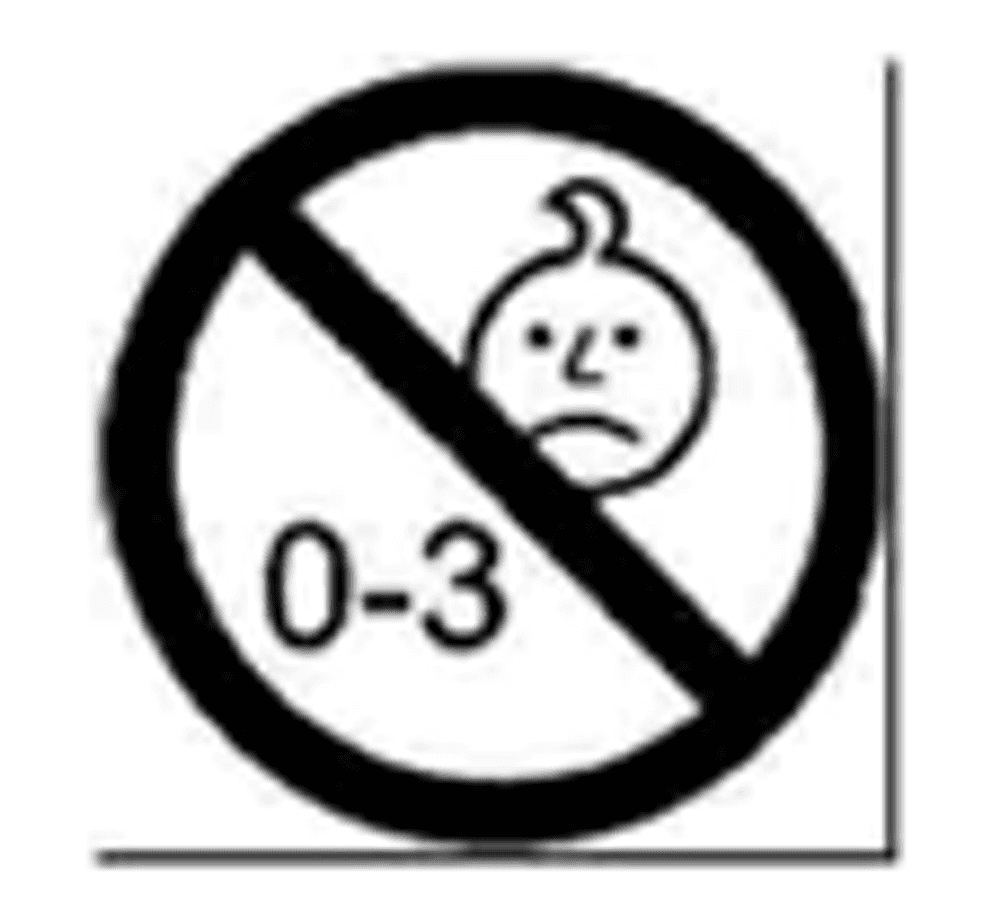
All warnings shall be preceded by the word “Warning” or by a generic pictogram which shall be displayed in a prominent way
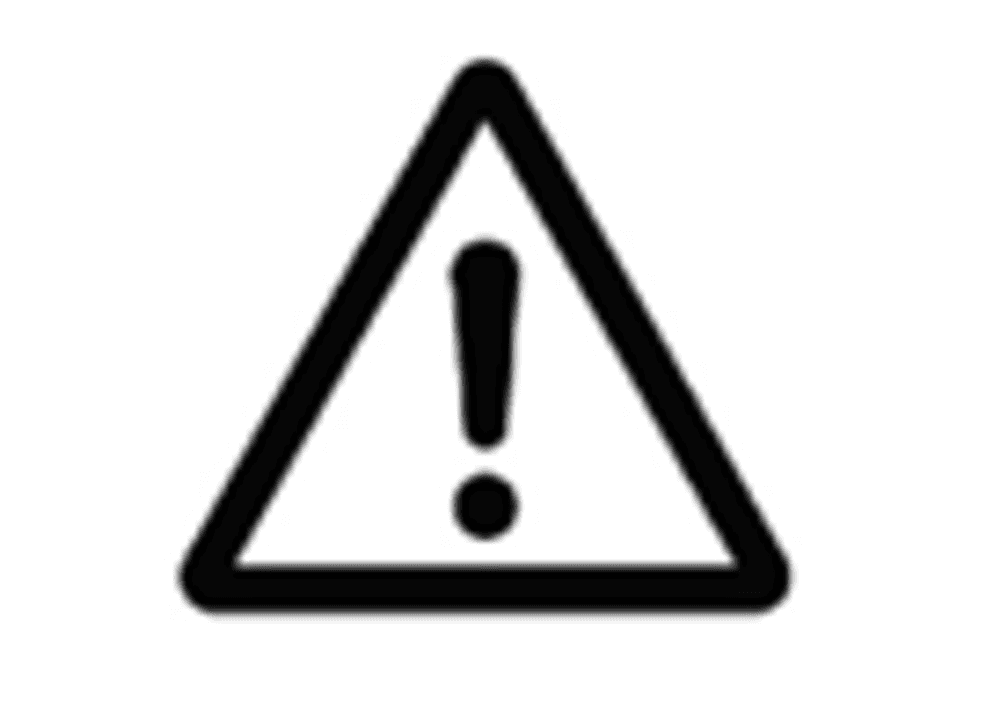
5. Digital Product Passport
The DPP will replace the EU declaration of conformity (DoC). It will include product-specific data such as the DoC and additional information accessible electronically via a data carrier
The Commission is required to adopt delegated acts within 12 months after the date of entry into force (EIF) of the TSR to define technical requirements for the DPP
The Commission will issue practical guidelines and tailor-made guidance to assist small and medium-sized enterprises (SMEs) in establishing a DPP. An automatic translation tool must be provided for official languages in Member States where the toy is marketed. These resources will be available within one year after the EIF of the TSR
A back-up copy of the digital product passport shall be available through a digital product passport service provider
By completing the DPP and applying the CE marking, the manufacturer is making a declaration that their toy follows the requirements of the Regulation and takes full responsibility for the toy
6. Integration with the General Product Safety Regulation (GPSR)
The TSR is designed to operate complementary to GPSR (EU) 2023/988. Online marketplaces must adhere to Article 22 of Regulation (EU) 2023/988 on product safety
7. Technical Documentation
Amends the elements to be included in the technical documentation:
A detailed description of the design and manufacture including a list of components and materials used in the toy is required
A list of substances and mixtures used, to include the safety data sheet (SDS), is required to be part of the technical documentation
Transitional Provisions:
The TSD will be repealed on the first day of the month following 54 months after the EIF
A transitional period of 30 months after the EIF of the TSR will be in place
ECHA announced a consultation phase for potential inclusion of 1,1'-(ethane-1,2-diyl)bis[pentabromobenzene] (Abbreviation: DBDPE) as SVHC. Should this listing be approved, the number of substances recognized on the SVHC Candidate List will be updated to 251 entries.
On 27 June 2025, the European Chemical Agency (ECHA) launched a 45-days public consultation on 1,1'-(ethane-1,2-diyl)bis[pentabromobenzene (DBDPE) as a new potential Substance of Very High Concern (SVHC). A decision will be made whether this substance will be included in the ECHA Candidate List of SVHC after the consultation period which will end on 11 August 2025.
If approved as an addition to the Candidate List, the number of SVHCs will be updated from 250 entries to 251 entries.
Highlights regarding this substance are shown in the table below.
| Substance name | EC number | CAS number | Reason for inclusion | Possible usage |
| 1,1'-(ethane-1,2-diyl)bis[pentabromobenzene] (DPDPE) | 284-366-9 | 84852-53-9 | vPvB* (Article 57e) | Formulation of flame retardants Thermoplastics in various sectors, including: electronic and electrical components and electronic enclosures construction (building, roofing) automotive (e.g. wires and cables) Formulation of adhesives, sealants, coatings and inks Wood plastic composite Foam used in construction |
*Remark:
VPvB = very Persistent and very Bioaccumulative
It is important for manufacturers, importers and distributors to continually review materials and products to ensure compliance with SVHC.
The European Union has approved Regulation (EU) 2025/843 to add UV-328 to the chemical list in Part A of Annex I to Regulation (EU) 2019/1021 (the POPs regulation) to phase out its use.
On 5 May 2025, the European Commission approved Regulation (EU) 2025/843 to add UV-328 to Part A of Annex I to the Persistent Organic Pollutants (POPs) regulation, Regulation (EU) 2019/1021.
Annex A, as outlined in point (4) of (EU) 2025/843, contains a list of chemicals in which each Party to the Convention is required to prohibit the chemicals on the list and/or take the legal and administrative measures necessary to eliminate their production, use, import and export.
Here is how the phase-out of UV-328 will be managed:
| Substance name | EC number | CAS number | Exemption on intermediate use or other specification |
| ‘2-(2H-benzotriazol-2-yl)-4,6-di-tert-pentylphenol (UV-328) | 247-384-8 | 25973-55-1 | Specification (in substances, mixtures or articles) |
| 100 mg/kg (0,01 % by weight) - from 4 August 2025 10 mg/kg (0,001 % by weight) - from 4 August 2027 1 mg/kg (0,0001 % by weight) - from 4 August 2029 Exemption (Including but not limited to:) Land-based motor vehicles - until 4 August 2030 Industrial coating for land-based motor vehicles, engineering machines, rail transportation vehicles, and in heavy-duty coating for large steel structures - until 4 August 2030 Mechanical separators in blood collection tubes -until 4 August 2030 Triacetyl cellulose film in polarizers - until 4 August 2030 Photographic paper - until 4 August 2030 Civilian and military aircrafts - until 4 August 2030 |
*Remark:
Date of entry into force is pending notification.
Interested parties shall take necessary measures in advance to comply with the upcoming requirement.
China News
In China, when hazards are identified in consumer products, they will be recalled and published in the SAMR Defective Product Administrative Centre, which is updated daily. The China recalls from 01 June 2025 to 30 June 2025 are summarized below:
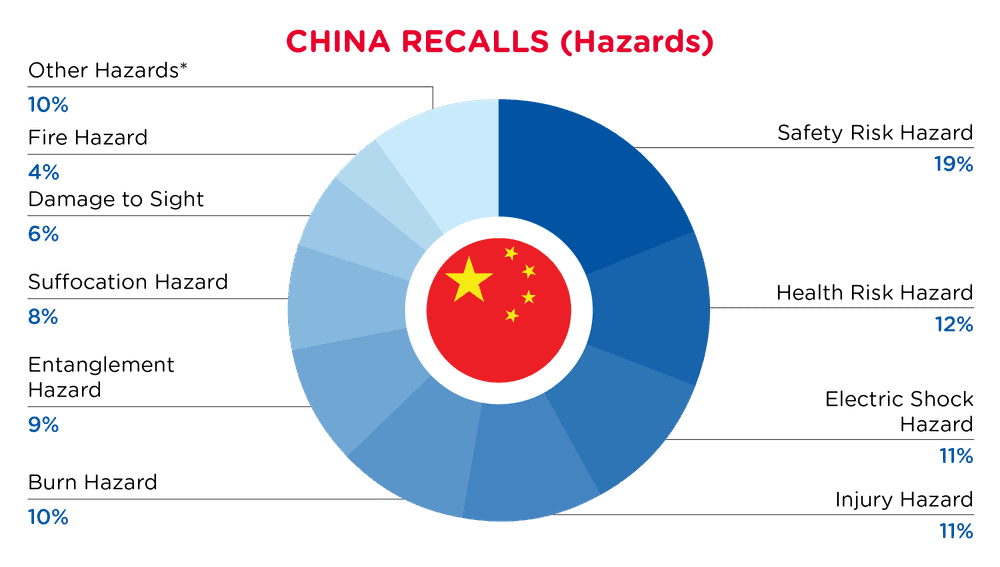
| Hazards | Frequency |
| Safety Risk Hazard | 15 |
| Health Risk Hazard | 9 |
| Electric Shock Hazard | 9 |
| Injury Hazard | 9 |
| Burn Hazard | 8 |
| Entanglement Hazard | 7 |
| Suffocation Hazard | 6 |
| Damage to Sight | 5 |
| Fire Hazard | 3 |
| Other Hazards* | 8 |
*Other Hazards include Ingestion Hazard, Crash Hazard, Laceration Hazard, Impact Hazard, Skin Irritation Risk, Carbon Monoxide Poisoning Hazard and Poisoning Hazard with a frequency of less than 3.
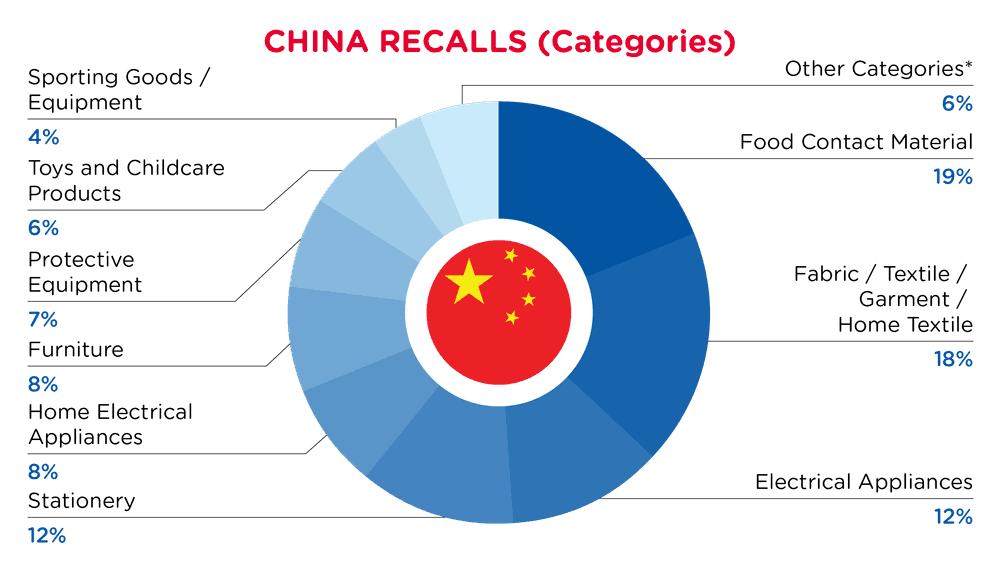
| Product Categories | Frequency |
| Food Contact Material | 14 |
| Fabric / Textile / Garment / Home Textile | 13 |
| Electrical Appliances | 9 |
| Stationery | 9 |
| Home Electrical Appliances | 6 |
| Furniture | 6 |
| Protective Equipment | 5 |
| Toys and Childcare Products | 4 |
| Sporting Goods / Equipment | 3 |
| Other Categories* | 4 |
*Other Categories include Footwear, Computer / Audio / Video / Other Electronics & Accessories and Chemicals with a frequency of less than 3.
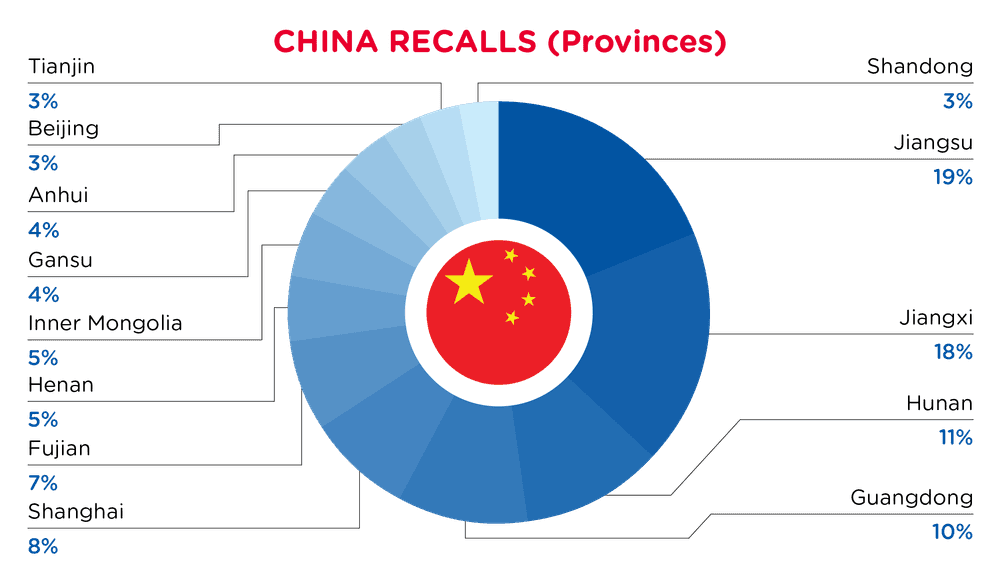
| Provinces | Frequency |
| Jiangsu | 14 |
| Jiangxi | 13 |
| Hunan | 8 |
| Guangdong | 7 |
| Shanghai | 6 |
| Fujian | 5 |
| Henan | 4 |
| Inner Mongolia | 4 |
| Gansu | 3 |
| Anhui | 3 |
| Beijing | 2 |
| Tianjin | 2 |
| Shandong | 2 |
For a complete list click here
Australia/New Zealand News
In Australia, when hazards are identified in consumer products, they will be recalled and published in the Recalls and Safety Alerts Database on the Australian Competition & Consumer Commission website, which is updated daily. The Australia recalls from 01 June 2025 to 30 June 2025 are summarized below:

| Hazards | Frequency |
| Injury Hazard | 13 |
| Choking Hazard | 8 |
| Risk of Death | 7 |
| Burn Hazard | 2 |
| Fire Hazard | 1 |
| Damage to Hearing | 1 |
| Drowning Hazard | 1 |
| Ingestion Hazard | 1 |
| Swallowing Risk | 1 |
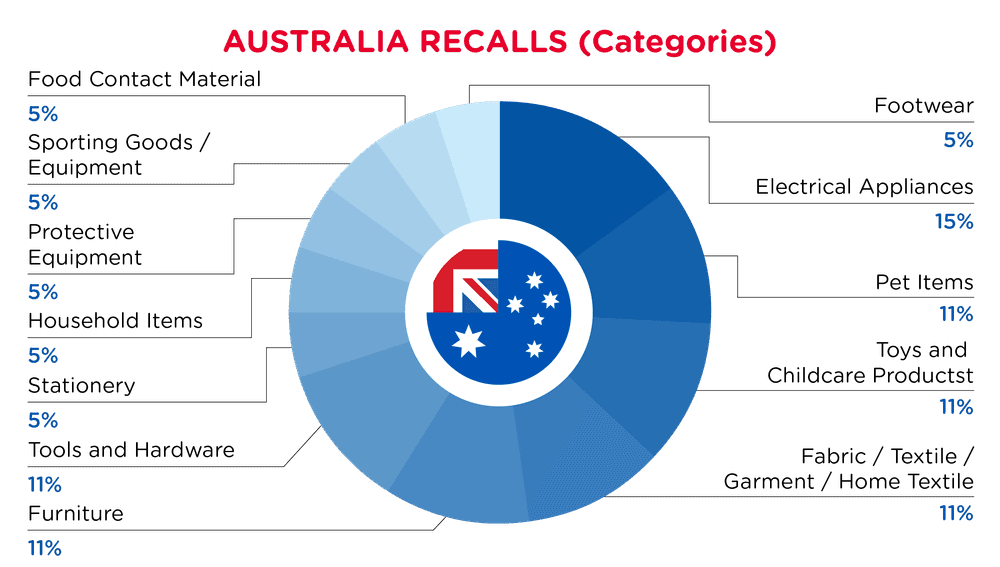
| Product Categories | Frequency |
| Electrical Appliances | 3 |
| Pet Items | 2 |
| Toys and Childcare Products | 2 |
| Fabric / Textile / Garment / Home Textile | 2 |
| Furniture | 2 |
| Tools and Hardware | 2 |
| Stationery | 1 |
| Household Items | 1 |
| Protective Equipment | 1 |
| Sporting Goods / Equipment | 1 |
| Food Contact Material | 1 |
| Footwear | 1 |
For a complete list click here
Subscribe to our Regulatory Updates
Unsubscribe at any time. Read our privacy policy.